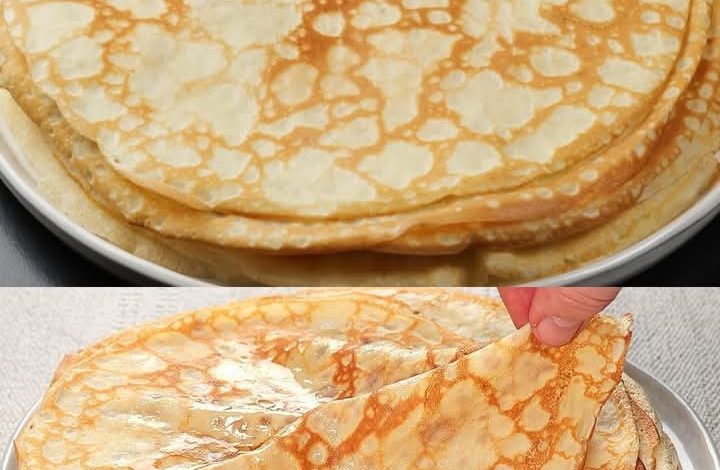
ADVERTISEMENT
Delicate and Lacy French Crepes: A Timeless Culinary Delight
Introduction
Crepes are one of the most beloved and versatile dishes in French cuisine, known for their ultra-thin, lacy texture and delicate golden color. Whether served sweet or savory, these light pancakes are a perfect base for countless flavors. The images above beautifully capture the thin and soft texture of these crepes, demonstrating their flexibility and inviting appeal. Crepes can be enjoyed at any time of the day—breakfast, brunch, dessert, or even as a light dinner. In this article, we will explore the history of crepes, their preparation techniques, and the best ways to serve them.
The Origins and Popularity of Crepes
Crepes have a rich history that dates back to 13th-century France, originating from Brittany, a region known for its culinary traditions. Initially, crepes were made using buckwheat flour, particularly for savory variations. Over time, wheat flour became more common, leading to the development of the delicate and soft crepes that are popular today.
What makes crepes so special is their incredible versatility. They can be paired with sweet ingredients like chocolate, fruits, and whipped cream, or with savory fillings such as cheese, ham, eggs, and vegetables. The characteristic lacy pattern seen in the image is a sign of well-made batter and proper cooking technique.
How to Make the Perfect French Crepes
Ingredients:
- 1 cup (125g) all-purpose flour
- 2 large eggs
- 1 ½ cups (360ml) milk
- 2 tablespoons melted butter (plus extra for cooking)
- 1 tablespoon sugar (for sweet crepes)
- ½ teaspoon salt
- 1 teaspoon vanilla extract (optional, for sweet crepes)
Instructions:
- Prepare the Batter: In a large bowl, whisk together the flour and salt. In a separate bowl, beat the eggs and gradually add the milk while whisking. Slowly add the wet mixture to the dry ingredients, whisking continuously to create a smooth, lump-free batter. Stir in the melted butter, sugar (for sweet crepes), and vanilla extract if making sweet crepes. Let the batter rest for at least 30 minutes to develop the perfect texture.
- Heat the Pan: Use a non-stick crepe pan or skillet and set it over medium heat. Lightly grease with a small amount of melted butter or cooking spray.
- Cook the Crepes: Pour ¼ cup of batter into the pan, tilting it in a circular motion to spread the batter evenly. Cook for about 1-2 minutes, until the edges start to lift and the bottom turns golden brown. Flip the crepe gently and cook for another 30-40 seconds until lightly golden.
- Stack and Serve: Transfer the cooked crepes onto a plate and keep them covered with a clean kitchen towel to retain warmth. Repeat the process until all the batter is used.
Serving Suggestions
Crepes are endlessly adaptable, making them ideal for both sweet and savory dishes. Here are some delicious serving ideas:
✔ Sweet Crepes:
ADVERTISEMENT
- Classic sugar and lemon juice
- Nutella and banana slices
- Strawberry and whipped cream
- Honey and almonds
✔ Savory Crepes:
- Ham and melted cheese
- Spinach and ricotta cheese
- Smoked salmon with cream cheese
- Mushrooms and garlic butter
For an authentic experience, serve crepes with a cup of coffee, tea, or fresh juice. They can also be folded into different shapes—rolled, folded into triangles, or layered into a crepe cake!
Conclusion
Crepes are an elegant yet simple dish that brings people together over a delightful meal. Their thin, soft, and lacy texture, as seen in the images, makes them perfect for enjoying with both sweet and savory toppings. Whether served for breakfast, brunch, or dessert, crepes are a classic favorite that never goes out of style. Mastering the technique of making crepes is a rewarding skill that allows you to enjoy this timeless dish in countless delicious ways. Try this recipe today and experience the magic of homemade French crepes!
ADVERTISEMENT




